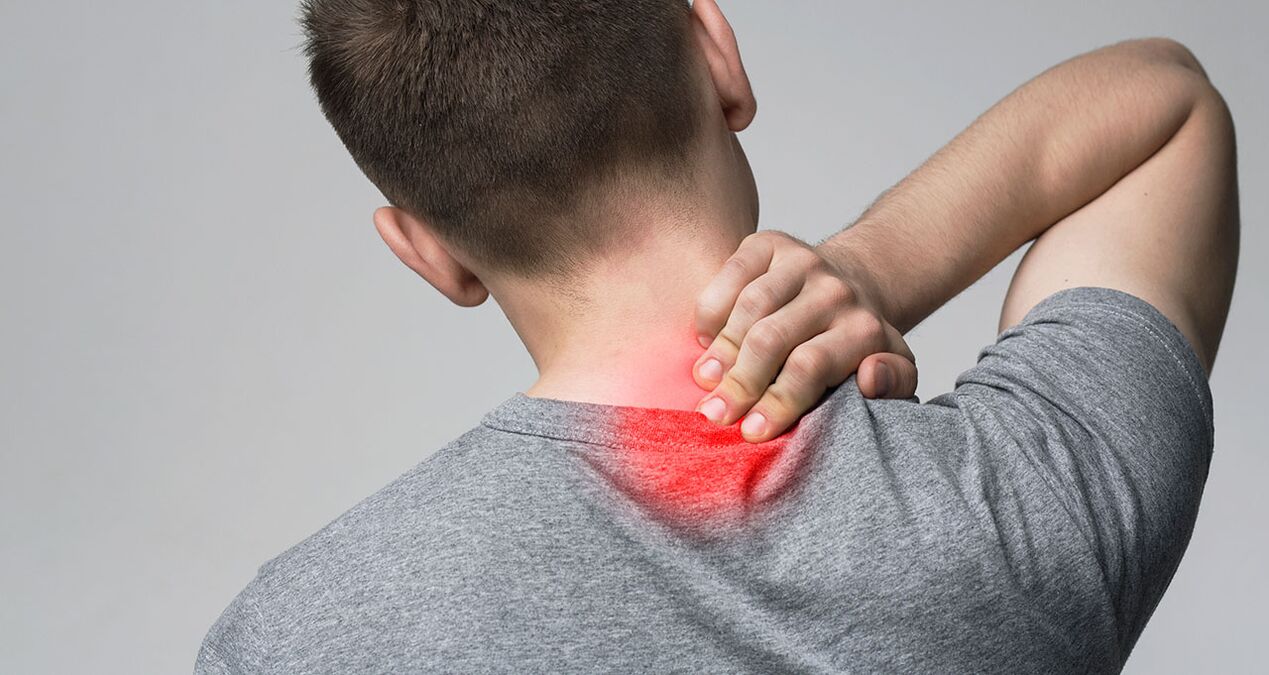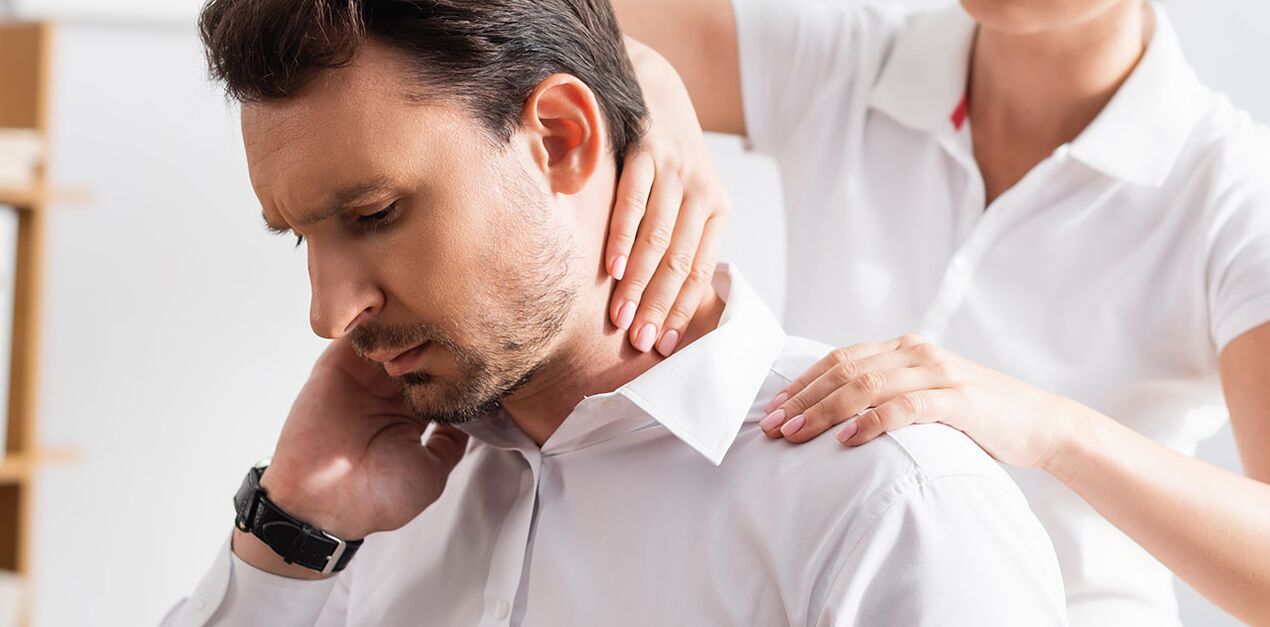

General characteristics
Types of neck pain
- Acute neck pain - lasts no more than 10 days and disappears after the triggering factors are eliminated.
- Chronic neck pain - lasts for more than three weeks, comes back, or persists.

causes of neck pain
- Sitting in front of a computer for long periods of time;
- Overexertion, such as during sports or manual labor;
- Underdeveloped muscles;
- increased muscle tone;
- Hypothermia, exposure to drafts;
- Incorrect sleeping position;
- Accidents (cervical sprain, cervical spine injury);
- degenerative dystrophic changes in the spine;
- colds and viral infections;
- hormonal changes during menopause;
- stress, depression and anxiety;
- Mineral deficiency.
Front of Neck Pain: Causes
- Thyroid diseases (toxic goiter, Hashimoto's thyroiditis) - discomfort occurs due to inflammatory processes and endocrine pathology. Increased pain is observed with forward bending and movement. This is accompanied by an increase in body temperature, increased heart rate, sensation of heat, and increased sweating.
- Sialadenitis is an injury to the salivary glands in the jaw. The pain worsens with swallowing, chewing movements, and turning the head. and is accompanied by the formation of swelling and compaction. It is characterized by dry mouth and difficulty eating. It occurs with weakness, chills, and fever.
- Purulent inflammation of the pharynx - the spread of the inflammatory process to adjacent tissues, leading to the formation of a retropharyngeal abscess. The discomfort is also accompanied by redness of the skin on the front of the neck, which turns bright pink and feels hot to the touch. The pain is severe and intense, so the patient may refuse to eat. Related to fever. This is the result of an extensive paratonsillar abscess.
- Cervical plexitis - The intensity of the clinical manifestations depends on the number of damaged neural structures. Most often, severe pain occurs in the anterolateral part of the neck. Coughing and difficulty speaking. The discomfort radiates to the ears, chest, and back of the head. There is a "crawling" and paresthesia sensation. Occurs due to injury, hypothermia, or following vaccination.
- Rheumatic diseases are systemic diseases of connective tissue (collagen degeneration) that damage the skin and muscles. Dermatomyositis and scleroderma are characterized by persistent and persistent pain. The skin appears swollen and thickened. Shooting pain can radiate into the neck and front of the spine.
- Lymphadenitis - discomfort located in the upper neck. Lymphoid tissue is affected. The discomfort is concentrated in the submandibular area, usually on one side. Symptoms progress with head tilt and talking. The skin becomes congested and swollen. It is accompanied by inflammation of the lymph nodes, general weakness, and fever.
Back of Neck Pain: Causes
- Osteochondrosis is associated with degenerative dystrophic disease of the intervertebral disc, loss of disc strength, and loss of height.
- Herniation is a complication of osteochondrosis, accompanied by disc herniation. The herniation is caused by invasion of the vertebral arteries and neural structures.
- An intervertebral hernia occurs when the protrusion pushes forward. The internal contents of the intervertebral disc enter the spinal canal and compress the nerve endings.
- Spondylosis - bony protrusions (osteophytes) appear at the edges of the vertebral bodies, along with a reduction in disc size, fusion of adjacent vertebrae, and limited movement of the neck.
Side Neck Pain: Causes
Diagnosis of causes of neck pain
- Submandibular Salivary Gland and Thyroid Ultrasound - Used to quickly visualize neck structures and identify internal organ disorders causing neck pain. A duplex scan is performed to scan large vessels and determine blood flow status.
- X-ray or CT (computed tomography) - determines displacement of vertebrae and bone deformation. Enables you to determine the extent of spinal disease and the nature of the disease.
- Functional Diagnosis - Use cervical spine MRI to identify injuries to the musculature.

Neck pain treatment
Pre-diagnosis help
Pills and Ointments for Neck Pain
Exercises for Neck Pain
- Lie on your back with your head on a flat but not soft pillow until you count to 5 (from 5 to 7);
- Lie on your side, lift your head and hold until you count 5 (at least 5 is close);
- Lie on your stomach with your arms crossed behind your head and your head raised, providing light resistance (4 to 6 reps).
What not to do if you have neck pain
- Maintaining a forced position for a long time puts the neck under tension.
- Lift heavy objects and perform physical tasks.
- Experiencing severe stress can cause blood vessels to spasm, which can negatively impact circulation.
- Regular drinking and smoking can lead to persistent narrowing of blood vessel structures.
- Wear clothes that are inappropriate for the weather, do not dress in the cold season, and do not wear hats or scarves.
When you need to see a doctor urgently

medical treatement
- NSAIDs – Relieve discomfort and swelling and eliminate residual inflammation;
- Analgesics - relieve pain and improve general condition, but do not eliminate the cause;
- Corticosteroids – reduce inflammation and affect muscle excitability;
- Muscle Relaxants – Relieve painful muscle tension and improve motor activity.
Surgery
manual therapy
physiotherapy
- SMT (Sinusoidal Modulated Current) – Stimulates the production of bioactive substances in the body. Electrophoresis can relieve pain and restore mobility, activating your own defenses. The complex procedure allows you to achieve significant and long-lasting analgesia, complemented by anti-inflammatory and anti-edematous effects.
- MLT (Magnetic Field and Laser Beam) – Provides significant therapeutic effects. The purpose of this procedure is to activate specific enzymes, change capillary osmotic pressure and improve blood circulation.
- UVT (Shock Wave Therapy) - with the help of low-frequency sound waves, initiates the process of improving microcirculation. Inflammation is reduced, swelling is eliminated, and pain is relieved.
exercise therapy
- The main task is to exercise muscles and make them elastic;
- Movements should be smooth, as violent and rapid movements will only aggravate the condition;
- Exercises should be performed on a flat surface using special mats and rollers.
- Exercise 1 – Turn your head to the far right, then to the left. Provides mobility of the cervical spine.
- Exercise 2 – Lower your head and press your chin toward your chest to feel your ribcage. This exercise can improve neck mobility and relieve muscle stiffness.
- Exercise 3 – Tilt your head back and retract your chin. Exercise can improve the posture of your cervical spine.
Which doctors should I contact for neck pain?



















